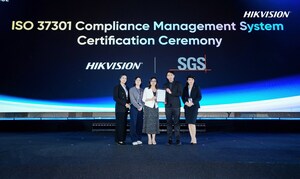Hikvision unleashes the power of large-scale AI in traffic management by introducing next-generation traffic cameras and servers
HANGZHOU, China, July 30, 2025 /PRNewswire/ -- Hikvision, a global leader in the AI-powered Internet of Things (AIoT), has released a suite of next generation checkpoint cameras, traffic incident detection cameras, and servers, powered by advanced large-scale Traffic AI models. These innovative products are designed to significantly enhance detection accuracy, reduce false alarms, and improve overall traffic safety.
Revolutionary AI models for smarter detection
Hikvision's large-scale traffic AI models are based on the Guanlan Large-Scale AI Model platform. They have been developed with deep traffic industry knowledge and are trained on millions of complex real-world situations such as rainy roads, construction areas, and extreme weather.
The models use the Transformer architecture, an AI-building approach that allows simultaneous viewing of data parts. It assists the models by identifying complex features and can rapidly determine the relationships between different elements in a traffic scene.
The self-attention mechanism in these models enables better extraction of overall features. Instead of just focusing on individual details, they analyze the whole picture to understand the context. This significantly reduces false detections caused by the background.
Checkpoint cameras: 75% fewer false alarms
Hikvision's new checkpoint cameras with large-scale AI models (iDS-TCV9(C)00-HI, iDS-TCV9(C)07-HIR) address common traffic compliance monitoring challenges such as detecting seatbelt use and phone usage by drivers.
- For seatbelt detection
The self-attention mechanism evaluates the driver's posture and visible parts of the seatbelt—even when partially obscured—and reduces false alarms by 75%. The models' strong pre-training generalization and self-attention mechanisms allows them to work well in complex situations, such as when the seatbelt color matches the clothing or the belt has an unusual shape. - For detecting phone use
When it comes to detecting phone use, these cameras analyze multiple factors such as hand position, the area near the ear, and the driver's line of sight. By integrating industry knowledge rather than relying solely on the phone's shape, they reduce false phone use detections by 75%, meeting the need for high accuracy.
Traffic incident cameras and servers: 60% lower false detection rates
Hikvision's incident detection cameras (iDS-TCS802-HS, iDS-TCS907-HIR, iDS-TCS917-HI, iDS-TCS900-HI) and servers (iDS-TSS500-H/16, iDS-TSS300-H/04) leverage large-scale AI models to deliver a 60% reduction in false alarm rates for incidents like fallen objects, pedestrian detection, and stopped vehicles.
The cameras minimize background false detection by better understanding the image context. Their enhanced generalization ability allows them to detect rare targets and capture complex features, such as identifying event types based on key characteristics of personnel and vehicles. For example, they can identify reflective vests or emergency lights to accurately classify events. The servers, in turn, let users get these benefits using their existing cameras, avoiding the need to install new ones for road monitoring.
"These new cameras are a big step forward in traffic management efficiency," said Hollis Li, Intelligent Traffic Product Director at Hikvision. "With large-scale traffic AI models, our solutions are more accurate and better at handling real-world challenges. This means safer roads and more efficient traffic management for everyone."
Find out more
To learn more about Hikvision's intelligent checkpoint cameras, and incident detection cameras and servers with large-scale AI models, please visit our official website.







Share this article